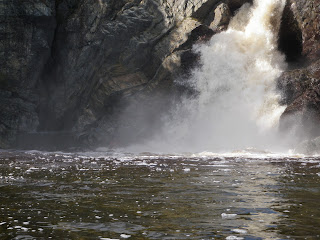Well, I had a feeling it was going to happen soon. While the suit is only 15 mos old, I could see tell tale signs that the neck gasket was getting soft. To be honest, I always thought that this particular gasket was rather thin. This was nice as it was not too restrictive yet it gave a good seal. Anyways, I was finally giving my suit a much-needed wash after the paddle on Sat when I noticed that the latex looked cracked. I stretched it a bit with my fingers and whammo, it ripped from top to bottom in one quick tear. Not that I wanted this to happen but it's better to have it happen at home than on the water somewhere!!
I'd done gaskets before so I was not fazed by the prospect of having to replace it. Actually my first gasket was not a replacement but rather a new installation. Cheryl's suit had a neoprene collar and I installed a new latext gasket. That was a much harder job than just replacing an existing rubber gasket.
 |
| Split from stem to stern!! |
A quick call to the Outfiters confirmed that they had an XL gasket in stock - thank gawd! Last time I did a neck gasket I borrowed the wooden discs and ring from a fellow paddler. This time I decided to make my own because a) I know I'd need them again sometime in the future and b) the individual I borrowed them from last year is "in between" houses right now and I rather not bother him to find them for me. A few pieces of scrap 4mm plywood and 30 minutes of work and I had my own set of jigs. The instructions provided by Kokatat gave sizes that did not work with the gasket I had purchased so I had to re-work the inside diameter of the ring to accommodate the difference in size.
I'm not sure if this is "standard" but the old gasket was stitched to the suit fabric and sealed with seam tape. There was no glue/sealant on the gasket, itself. This made removal of the gasket a bit harder but I managed to get a pretty clean surface.
 |
| Wooden disk wrapped in wax paper and in position. |
 |
| Getting ready to apply the Aquaseal. |
Last time I did a neck gasket I had to use a wide variety of clamps and clothes pins and "what have ya" to hold the gasket in place while the Aquaseal setup. The biggest job was trying to get even pressure to prevent creep. But not this time!!! Schedule 40 clamps came to the rescue once again!!! These simple little clamps are rapidly becoming my favourite tool - from
hatches, to
deck fittings, to
cockpit coamings, to
thigh braces, to
gunwales, back to
cockpit coamings and on to
fabric skin.
Once I positioned the gasket in place, I simply ran a ring of Schedule 40s around the whole jig and voila - even pressure all the way 'round with no creep!! Also, I was not fighting with the extra weight of the metal clamps that have a tendency to pull the fabric downward and cause movement of the gasket.
 |
| Looks like some kind of insect!! |
 |
| Modern art?? |
After making sure that the everything was seated propely I left the whole thing overnight. The next morning I pulled off the clamps, removed the jigs and BADDA BOOM BADDA BING, a "factory" job
 |
| "Factory", as they say!! |
The first time I tried this operation, I was covered in head to toe with Aquaseal, the gasket tried to creep off the jigs, I cursed and swore etc etc. This time, it was almost too easy. Familiarity with the process and remaining calm are the big things - and, let's not forget that those Schedule clamps make all the difference in the world!!
Now I need to do a "real world" test to see how it all works out, i.e., check for leaks!! I'll also have to be bit more vigilant with the UV protectant as well!!
Thanks for dropping by,
Sean





































